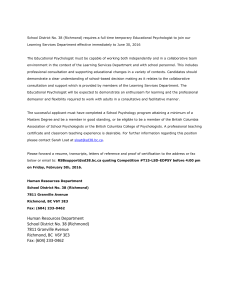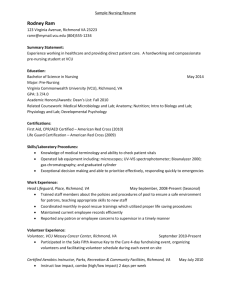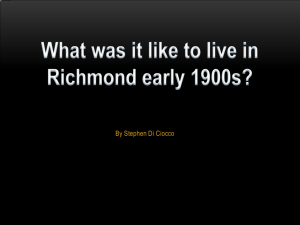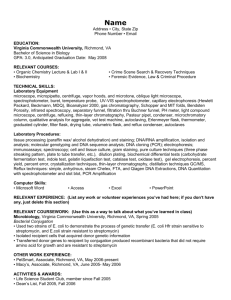Ann Richmond`s laboratory gains new insights into tumor growth
advertisement
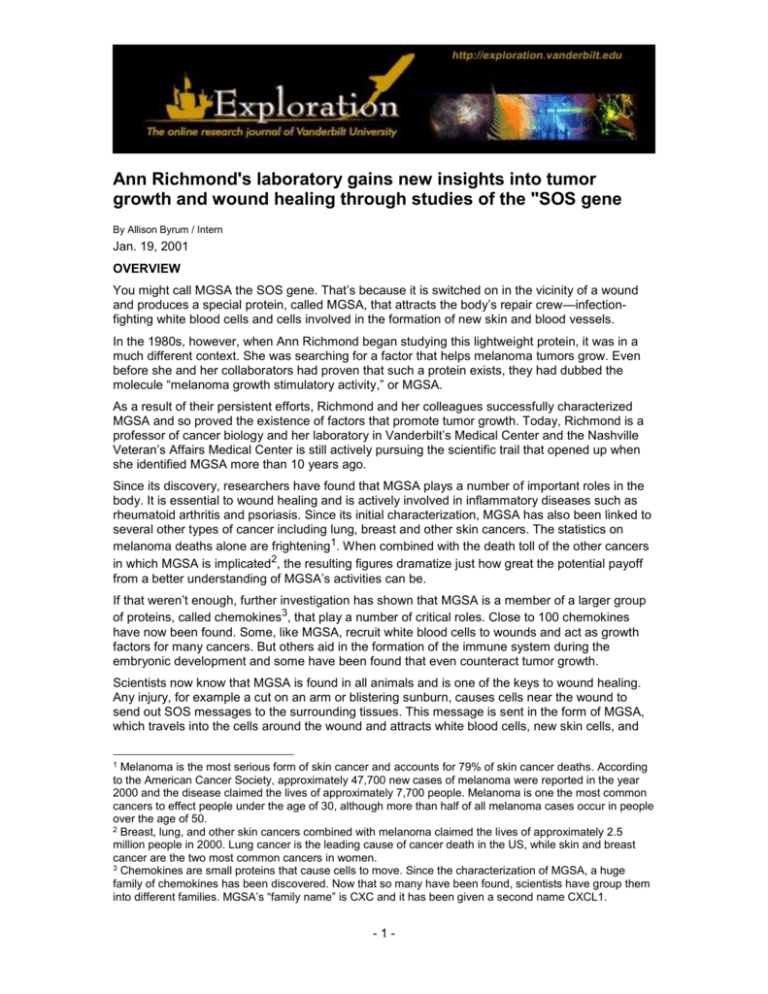
Ann Richmond's laboratory gains new insights into tumor growth and wound healing through studies of the "SOS gene By Allison Byrum / Intern Jan. 19, 2001 OVERVIEW You might call MGSA the SOS gene. That’s because it is switched on in the vicinity of a wound and produces a special protein, called MGSA, that attracts the body’s repair crew—infectionfighting white blood cells and cells involved in the formation of new skin and blood vessels. In the 1980s, however, when Ann Richmond began studying this lightweight protein, it was in a much different context. She was searching for a factor that helps melanoma tumors grow. Even before she and her collaborators had proven that such a protein exists, they had dubbed the molecule “melanoma growth stimulatory activity,” or MGSA. As a result of their persistent efforts, Richmond and her colleagues successfully characterized MGSA and so proved the existence of factors that promote tumor growth. Today, Richmond is a professor of cancer biology and her laboratory in Vanderbilt’s Medical Center and the Nashville Veteran’s Affairs Medical Center is still actively pursuing the scientific trail that opened up when she identified MGSA more than 10 years ago. Since its discovery, researchers have found that MGSA plays a number of important roles in the body. It is essential to wound healing and is actively involved in inflammatory diseases such as rheumatoid arthritis and psoriasis. Since its initial characterization, MGSA has also been linked to several other types of cancer including lung, breast and other skin cancers. The statistics on melanoma deaths alone are frightening1. When combined with the death toll of the other cancers in which MGSA is implicated2, the resulting figures dramatize just how great the potential payoff from a better understanding of MGSA’s activities can be. If that weren’t enough, further investigation has shown that MGSA is a member of a larger group of proteins, called chemokines3, that play a number of critical roles. Close to 100 chemokines have now been found. Some, like MGSA, recruit white blood cells to wounds and act as growth factors for many cancers. But others aid in the formation of the immune system during the embryonic development and some have been found that even counteract tumor growth. Scientists now know that MGSA is found in all animals and is one of the keys to wound healing. Any injury, for example a cut on an arm or blistering sunburn, causes cells near the wound to send out SOS messages to the surrounding tissues. This message is sent in the form of MGSA, which travels into the cells around the wound and attracts white blood cells, new skin cells, and 1 Melanoma is the most serious form of skin cancer and accounts for 79% of skin cancer deaths. According to the American Cancer Society, approximately 47,700 new cases of melanoma were reported in the year 2000 and the disease claimed the lives of approximately 7,700 people. Melanoma is one the most common cancers to effect people under the age of 30, although more than half of all melanoma cases occur in people over the age of 50. 2 Breast, lung, and other skin cancers combined with melanoma claimed the lives of approximately 2.5 million people in 2000. Lung cancer is the leading cause of cancer death in the US, while skin and breast cancer are the two most common cancers in women. 3 Chemokines are small proteins that cause cells to move. Since the characterization of MGSA, a huge family of chemokines has been discovered. Now that so many have been found, scientists have group them into different families. MGSA’s “family name” is CXC and it has been given a second name CXCL1. -1- Ann Richmond's laboratory gains new insights into tumor growth and wound healing through studies of the "SOS gene OVERVIEW cells required to form new blood vessels to the damaged site. Once this repair team is assembled, the SOS message is cut off. Help has arrived and no more MGSA is needed. Problems can arise, however, when the SOS message does not turn off normally. When MGSA is continuously produced, the body continues to respond long after the appropriate help has arrived. In certain circumstances, this can give rise to tumors. In addition, established tumors produce MGSA in order to establish connections to nearby blood vessels. “In many ways, tumors are like never-healing wounds,” Richmond says.4 Before Richmond characterized MGSA, little was known about this class of proteins. A postdoctoral fellow at Emory University at the time, she hypothesized that melanoma tumor cells must be producing something that promotes their growth. She and Dave Lawson 5, who was an oncologist at Emory, set out to purify the protein that they guessed was helping tumors grow. The research was not easy. In order to get samples of melanoma to experiment with, Richmond and Lawson had to visit melanoma patients in the hospital to get their informed consent. Richmond describes this as one of the most trying experiences in her early research. Day after day she would sit at the bedsides of patients at different stages of the disease and listen to their stories, their hopes and their dreams. She still remembers many of the patients vividly, most of whom did not survive their illness. Nevertheless, “these experiences lit a flame of work in us,” Richmond remembers. “We had to continue for each of these people.” In addition to the emotional strains specific to the work, Richmond’s team had to cope with insufficient resources. The tiny lab they were given for their experiments barely accommodated their equipment, much less the researchers. That first summer “we only hired skinny people!” Richmond recalls, laughing. Space problems were compounded by the fact that the team did not have the funds they needed to buy new equipment. So they were forced to work late nights using borrowed equipment, which broke down all too frequently because of the unusual demands they were putting on it. Finally, however, grants came through and the research began moving. After seven years of research, a few blind alleys and many sleepless nights, Richmond and post-doctoral fellow Greg Thomas6 managed to purify and characterize MGSA. Midway through their characterization effort, the team discovered that the protein they were calling MGSA looked very similar to another already characterized protein: platelet factor four. Platelet factor four is a common factor found in the blood stream. Although the two proteins weren’t exactly the same, they were similar enough that Richmond became fearful that her protein was simply another version of the familiar factor. That caused her to seriously consider abandoning the attempt to complete her characterization of MGSA. Influenced by the counsel of a colleague 7, she decided to continue the effort. That was fortunate because not only did MGSA turn out to perform a completely different function than platelet factor four, but also the similarity that had alarmed Richmond initially proved to be significant: It opened 4 Angiogenesis is the outgrowth of tiny new capillaries from existing blood vessels. It is important in wound healing because new blood vessels must grow into the site of a wound to help it heal. It also contributes to tumor growth, since the new blood vessels feed the tumor. 5 Now associate professor of medicine at Emory University’s Winship Cancer Institute. 6 Later became department director at Solvay Pharmaceuticals in Atlanta. 7 Skip Catherwood, a research colleague at the Veterans Affairs Medical Center in Atlanta, Georgia, advised Richmond to follow through on the characterization. He advised Richmond to “play out the cards she had been dealt.” -2- Ann Richmond's laboratory gains new insights into tumor growth and wound healing through studies of the "SOS gene OVERVIEW the door to the discovery of the huge chemokine family, many of which have structural similarities to platelet factor four8. Today, Richmond continues to study MGSA and related chemokines. Her lab is currently pursuing three different research projects: MGSA transcription. Transcription is the first step in the process by which cells make proteins. In this step the information coded in DNA is copied onto a single strand of RNA. The information needed to form a given protein is cut out and consolidated into a strand of messenger RNA (mRNA), which serves as the template for the actual assembly of the protein. Richmond is investigating what triggers the transcription of MGSA mRNA and what shuts it off. If transcription can be regulated, then the amount of MGSA that is produced can be controlled as well. MGSA receptors. The researchers are characterizing receptors that recognize MGSA and thus participate in the wound healing and tumor growth processes. If these receptors can be understood in depth, then perhaps a way can be devised to keep them from reacting to excess MGSA. Wound healing and tumor growth. By investigating how normal cells heal, the researchers are attempting to determine the natural mechanisms that start and stop the production of MGSA. By using special chemokines9 that block the growth of new blood vessels to the tumor, the team is testing ways to block tumors from growing. Although much work remains before melanoma can be cured, Richmond’s outlook is positive. So much advancement has been made in the field of chemokine research since the characterization of MGSA, that new approaches to the problem are being designed every day. Each new assay 10 yields new information and a renewed chance to discover what makes tumors grow and how to stop them. Even if the exploration of MGSA’s activities does not lead to a cure for melanoma, the family of chemokines that it introduced could hold the answer to many of basic questions abut how the body works at a molecular level. 8 Today approximately fifty chemokines have been characterized and many more are under investigation. 9 Angiogenic and angiostatic chemokines are small proteins that cause the production of new blood vessels and those that counteract it. The two types of chemokines are very similar molecularly: they differ by only a few amino acids. But their biological functions are directly opposed to one another. 10 A scientific procedure that determines the quantity of a given substance present in a sample. -3- Ann Richmond's laboratory gains new insights into tumor growth and wound healing through studies of the "SOS gene BIOGRAPHY A soda clerk turned chemistry teacher and a developmental biologist with the reputation as one of the toughest and best members of his department are among the role models that have guided Ann Richmond in her career as a successful cancer researcher. As a schoolgirl growing up in a small town in Arkansas, Richmond relished challenging subjects. For that reason, she found science interesting, but it didn’t occur to her that it could be a career. There was one chemistry teacher, Mrs. Luke, who succeeded in fascinating Richmond in quantum theory and other aspects of the world of atoms and molecules. Despite a longtime interest in science, Mrs. Luke came to science teaching late in life. For many years, she was content to work behind the counter of the local soda fountain. But then a change in her family situation prompted her to get a teaching certificate and begin teaching chemistry at the local high school. Richmond recalls Mrs. Luke’s classes as the first science instruction that she truly enjoyed. The experience convinced her to minor in science when she earned her teaching degree in college. After she began teaching, Richmond realized that earning a master’s degree in chemistry would be good for her career. So she signed up. While studying for her master’s, she found that she really enjoyed research and so decided to get a doctorate. “I liked science because it was challenging,” Richmond recalls. “I always liked the classes that were the most difficult!” Given her penchant for challenges, it wasn’t surprising that Richmond chose one of the toughest mentors in the department of developmental biology at Emory University as her doctoral adviser. Professor Bill Elmer had a reputation as one of the toughest and one of the best, she recalls. Richmond remembers his interactive style in the lab as well as his effective teaching techniques. “He was probably the most influential role model I had during my early scientific career.” As she has continued to grow and mature as a scientist, however, Richmond has not limited her role models to Elmer and Mrs. Luke. “I have developed a collage of role models, based on many different men and women who have helped shape my scientific career, whom I have watched and learned from.” By the time Richmond was a postdoctoral fellow and beginning her work on MGSA, she was 33 years old with two small children. Lab life with its long hours and difficult problems was tough, but Richmond thrived on the challenge. She describes a scientific career as something of a roller coaster. At some points, the ride is fast and hard, but, at other points, the trip goes a little slower so that one can focus her time and energy on other important things. In the beginning years of the MGSA project, however, Richmond’s life seemed stuck on a fast and hard stretch. The research and the research conditions were challenging. Richmond spent many late nights in the library and the lab working on the MGSA puzzle. Part of her job was interviewing melanoma patients, and those experiences constantly refueled her. Each interview personalized the problem once again. Many of the patients were the same age as Richmond and in similar situations. Many were young mothers whose lives seemed interchangeable with her own. Two patients in particular made a lasting impression. One was a young mother of two whose illness progressed with startling rapidity. The woman was healthy enough to run the Peachtree Road Race in Atlanta in July but died from melanoma in December. Richmond was particularly touched by the woman’s story and the fate of her small children. The other was an older lady, whose disease had spread to her lungs. Richmond spent an entire evening talking with her. “She was warm and kind,” Richmond recalls, “The doctors said she had a bad case of the ‘oh-mylord’s,’ meaning that not only her body, but her will was tired of fighting the melanoma.” Richmond left the patient that evening and when she returned to work the next morning she learned that the woman had passed away during the night. Richmond’s job was then to extract tumor tissue -4- Ann Richmond's laboratory gains new insights into tumor growth and wound healing through studies of the "SOS gene BIOGRAPHY during the autopsy. When she saw the woman’s body, she fainted. “It hit me that one day someone will be there and the next day she won’t,” she recalls. “These patients lit a flame,” Richmond explains, “one that would not go out and could not be ignored.” Richmond relied on the stories of the people with whom she had talked for encouragement when the research became difficult. Late at night, often with her girls asleep beside her, memories of the men and women she had met who were fighting for their lives drove her to finish just one more experiment on the borrowed equipment. “I’ve never been a researcher without emotion,” Richmond says. -5- Ann Richmond's laboratory gains new insights into tumor growth and wound healing through studies of the "SOS gene BACKGROUND DNA DNA (deoxyribonucleic acid) is the master molecule of heredity. It is made up of two strands linked together by four bases in the form of a double helix. Each strand of DNA is made up of a backbone and bases that are strung in a precise order. The two strands of DNA come together like a zipper. The teeth, or bases, on one side of the zipper match with the corresponding bases on the other side. The bases are the nucleic acids adenine (A), guanine (G), cytosine (C), and thiamine (T). Adenine and thiamine always pair together, as do guanine and cytosine. The four bases are the letters in the alphabet of life. Transcription In the process called transcription, the two strands of DNA unzip so the bases are exposed. By assembling bases in the same sequence as that of one of the DNA strands, the protein machinery within the cell makes RNA, or ribonucleic acid. RNA is made up of the same four bases as DNA (except thiamine, which is replaced by uracil (U)), but it is single stranded. So RNA is a copy of half of the original DNA. Once the RNA is made, special proteins pare it down to the information-carrying sections, which are called exons. The sections that are cut out are called introns, or intervening sections. It is a process roughly analogous to editing video. Say a vacationer with a video camera shot a lot of video footage and wants to edit it into a short program to show friends and relatives. To do so, he must go through the footage and copy only the best scenes onto a new tape. Similarly, the cell’s machinery extracts only the sequences it needs to construct a given protein from the DNA and combines them in a temporary RNA copy, which is called messenger RNA, or mRNA. Translation Once messenger RNA is produced, translation begins. Translation is the process that produces a specific protein based on the blueprint contained in the mRNA. Proteins consist of chains of amino acids. Each amino acid is coded for by a sequence of three bases called a codon. For example, the codon containing the bases cytosine (A), guanine (G) and adenine (A) code for the amino acid alanine. Complicating the picture is the fact that several codons specify the same amino acid. Other codons mark the beginning and end of proteins: The codon AUG, for example, is called the start codon because it signals the beginning of a protein sequence. When an mRNA containing these instructions is released from the cell, it attaches to an organelle, called a ribosome, that acts as a microscopic protein factory. The ribosome reads each codon and attaches the correct amino acid to the growing protein molecule until it is completed. Protein characterization To identify the protein MGSA, Richmond had to reverse the normal translation and transcription process. She began with the complicated process of purifying the protein from tumor cells. She then used several different procedures that separated proteins by their charge and size to isolate MGSA. Once she had enough purified MGSA, Richmond turned to a process called microsequencing to determine the protein’s primary structure 11. Proteins are made of strings of amino acids. To determine the order in which the amino acids are assembled, amino acids must be knocked free from the end of the protein one by one and the identity of each amino acid determined. When only a small amount of the protein is present, the amino acid sequence is determined on a micro-scale, hence the term: microsequencing. This provides the order of the amino acids. Since several codons code for each amino acid, however, Richmond was forced to turn to yet another technology to determine the order of the bases in the messenger RNA: a technology called molecular cloning from a cDNA library. 11 Proteins also have what are referred to as primary, secondary, tertiary and quaternary structures. The primary structure refers to the order of the amino acids. Secondary and tertiary structures refer to how the protein folds. Quaternary structure refers to the way that several proteins group together. -6- Ann Richmond's laboratory gains new insights into tumor growth and wound healing through studies of the "SOS gene BACKGROUND cDNA Libraries In order to determine the structure of proteins, researchers are interested in the messenger RNA sequences that code for each amino acid. However, mRNA is unstable. It easily degrades under normal temperatures and conditions, making it difficult to work with directly. So researchers imitate nature by converting all the mRNA from a given source into DNA, which is extremely stable. Because these are copies of DNA, researchers call them cDNA libraries. The scientists use these libraries when they know portions of the amino acid sequence of a protein. From this information, they make a few matching codon sequences and then use this as a “hook” to catch the strands of DNA that contain matching sequences. Once they have retrieved the correct DNA sequence from the thousands contained in a cDNA library, they can obtain the sequence from the appropriate segment of the DNA and so nail down the gene’s exact sequence. DNA extraction, digestion and PCR Richmond’s team currently spends a portion of its time investigating the roles of different chemokines in processes such as wound healing and tumor growth. To do so, the researchers must know when the mice that they use as an animal model encode variant genes for specific chemokines. They do this by extracting some DNA from the animal and testing it to see if it has a given chemokine gene. First, a researcher removes a tiny bit of skin. Special chemicals are used to digest everything but the DNA. The DNA is then run through a process called a polymerase chain reaction. In the PCR process, the double-stranded DNA is heated just enough so that it opens up and can be copied. Researchers can regulate which sections of the DNA will be copied. By doing this repeatedly, a PCR machine can produce thousands of copies of a specific section of DNA. The multiplied DNA is then mixed with a loading dye and put onto one end of a gel, a material with the consistency of Jell-O that is spread about one-fourth-inch thick onto a sheet of hard plastic. Electricity is run through the gel in order to exert pressure on the DNA molecules. Smaller pieces of DNA move faster and so travel farther than the heavier ones. Once the gel has run for several minutes a fluorescent chemical called ethidium bromide, or EtBr, is added. EtBr mixes with the DNA and shows the DNA’s position when viewed under ultraviolet light. The test allows researchers to identify specific fragments of DNA. - VU - -7-


